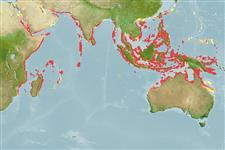Anthozoa |
Scleractinia |
Lobophylliidae
Environment: milieu / climate zone / depth range / distribution range
Ecology
Reef-associated; depth range 1 - 20 m (Ref. 98471). Tropical; 30°N - 25°S, 35°E - 155°E (Ref. 848)
Indo-West Pacific: East Africa including Red Sea to Guam, north to Philippines and south to Indonesia.
Length at first maturity / Size / Weight / Age
Maturity: Lm ? range ? - ? cm
Formation: mostly submassive. Corallites: cerioid to subplocoid, with moderately thin walls. Septa: thin and widely spaced; larger septa have very long teeth projecting upwards, causing a spiny appearance. Colonies usually not fleshy. Color: uniform or mottled brown, yellow, or green (Ref. 848).
Occurs in shallow reef environments (Ref. 848).
Life cycle and mating behavior
Maturity | Reproduction | Spawning | Eggs | Fecundity | Larvae
Members of the class Anthozoa are either gonochoric or hermaphroditic. Mature gametes are shed into the coelenteron and spawned through the mouth. Life cycle: The zygote develops into a planktonic planula larva. Metamorphosis begins with early morphogenesis of tentacles, septa and pharynx before larval settlement on the aboral end.
Scaps, P., V. Denis, S. Berhimpon and F. Runtukahu. 2007. (Ref. 83552)
IUCN Red List Status (Ref. 130435)
CITES status (Ref. 108899)
Not Evaluated
Threat to humans
Harmless
Human uses
| FishSource |
Tools
More information
Age/SizeGrowthLength-weightLength-lengthMorphologyLarvaeAbundance
Internet sources
Estimates based on models
Preferred temperature
(Ref.
115969): 26.7 - 29.3, mean 28.6 (based on 2847 cells).
